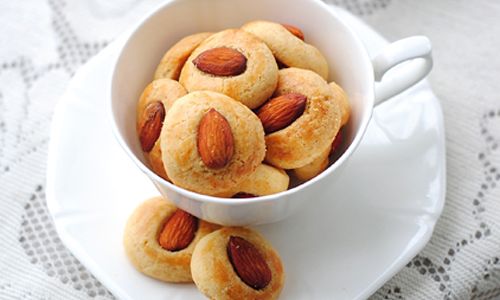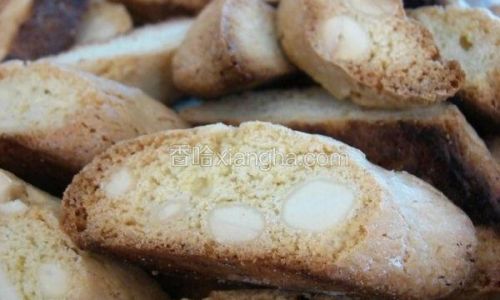Introduction
Baking is an art form that combines precision, creativity, and a deep understanding of ingredients to produce delightful treats that tantalize the taste buds. Among the myriad of baked goods, almond biscuits stand out for their delicate crunch, nutty aroma, and versatility. Whether you’re hosting a tea party, preparing a snack for a gathering, or simply indulging in a sweet moment alone, mastering the art of making crispy and delicious almond biscuits can elevate your baking skills and delight your loved ones.

In this comprehensive guide, we’ll delve into the intricacies of crafting perfect almond biscuits. From selecting the right ingredients to mastering the baking process, we’ll cover every aspect to ensure your biscuits are not only crispy but also bursting with flavor. By the end of this article, you’ll have the knowledge and skills to create almond biscuits that are the epitome of culinary excellence.
Chapter 1: Understanding the Ingredients
Before diving into the recipe, it’s crucial to understand the role each ingredient plays in achieving the desired texture and flavor of your almond biscuits.
1 Almonds
Almonds are the cornerstone of almond biscuits, providing both texture and flavor. Choose whole, unsalted almonds for the best results. Blanched almonds (those with the skin removed) will give your biscuits a smoother appearance, while unblanched almonds add a touch of rustic charm and additional fiber. Toast the almonds lightly before using them to enhance their natural oils and deepen their flavor.
2 Flour
All-purpose flour is the standard choice for almond biscuits, as it provides the necessary structure without being too heavy. However, you can experiment with other types of flour, such as almond flour or a combination of all-purpose and whole wheat flour, to create unique textures and flavors.
3 Sugar
Granulated sugar adds sweetness and helps with browning during baking. For a richer flavor, consider using a mix of granulated and brown sugar. Brown sugar contains molasses, which adds moisture and a hint of caramelization, making your biscuits softer on the inside and crispier on the outside.
4 Butter
High-quality unsalted butter is essential for creating tender, flavorful biscuits. The fat in butter contributes to the moisture content and overall texture, while its rich flavor complements the almonds perfectly. Make sure the butter is at room temperature to ensure it blends smoothly with the other ingredients.
5 Leavening Agents
Baking powder and baking soda are the leavening agents that give your biscuits their lift. Baking powder is a double-acting leavening agent that releases gas both when it comes into contact with liquid and when heated, causing the biscuits to rise. Baking soda, on the other hand, reacts immediately with acidic ingredients (like buttermilk or vinegar) to produce carbon dioxide, which helps the biscuits rise quickly.
6 Salt
Salt enhances the flavors of the almonds and sugar, making each bite more satisfying. A pinch of sea salt or kosher salt is all you need to bring out the best in your biscuits.

7 Extracts and Spices
While optional, adding a few drops of almond extract or vanilla extract can deepen the flavor profile of your biscuits. Ground cinnamon, nutmeg, or a touch of cardamom can also add complexity and warmth.
Chapter 2: Preparing the Ingredients
Now that you understand the role of each ingredient, let’s move on to preparing them for baking.
1 Toasting the Almonds
Preheat your oven to 350°F (175°C). Spread the almonds in a single layer on a baking sheet and toast them for about 8-10 minutes, stirring occasionally to ensure even toasting. Remove from the oven and let them cool slightly before chopping them into coarse pieces. Be careful not to over-toast them, as this can make them bitter.
2 Measuring and Mixing
Measure all your dry ingredients (flour, sugar, baking powder, baking soda, and salt) accurately using spoon-and-level method to avoid packing them down. This ensures consistent results.
In a separate bowl, cream the butter and sugar together until light and fluffy. This can be done using a hand mixer or a stand mixer fitted with the paddle attachment. Once the butter and sugar are well combined, add the eggs one at a time, beating well after each addition. If using, mix in the extracts at this stage.
3 Combining Wet and Dry Ingredients
Gradually add the dry ingredients to the wet ingredients, mixing on low speed until just combined. Avoid over-mixing, as this can lead to tough biscuits. Fold in the toasted almond pieces gently with a spatula to ensure they are evenly distributed throughout the dough.
Chapter 3: Shaping and Baking
Shaping your biscuits correctly and baking them at the right temperature are crucial steps to achieving that perfect crispy texture.
1 Shaping the Dough
Transfer the dough to a lightly floured surface and roll it out to about 1/4-inch thickness. Use cookie cutters to cut out shapes, or simply cut the dough into rectangles or squares with a knife. Place the shaped dough pieces onto ungreased baking sheets, spacing them slightly apart to allow for expansion during baking.

2 Chilling the Dough (Optional)
For an extra crisp texture, chill the shaped dough in the refrigerator for about 30 minutes before baking. This step helps to firm up the butter, which results in less spreading during baking and a crisper final texture.
3 Baking
Preheat your oven to 375°F (190°C). Bake the biscuits for about 12-15 minutes, or until the edges are golden brown and the centers are set. Rotate the baking sheets halfway through to ensure even baking.
Chapter 4: Cooling and Storing
Once baked, proper cooling and storage are essential to maintain the crispiness and flavor of your almond biscuits.
1 Cooling
Allow the biscuits to cool on the baking sheets for about 5 minutes before transferring them to a wire rack to cool completely. This helps them set and prevents them from becoming soggy.
2 Storing
Store your cooled biscuits in an airtight container at room temperature for up to 3 days. For longer storage, you can freeze them for up to 3 months. To freeze, place the cooled biscuits in a single layer on a baking sheet and freeze until solid. Then, transfer them to an airtight freezer bag or container. To serve, thaw at room temperature or warm them slightly in a preheated oven at 300°F (150°C) for 5-7 minutes.
Chapter 5: Troubleshooting and Tips
Even the most seasoned bakers encounter issues sometimes. Here are some troubleshooting tips and additional advice to help you perfect your almond biscuits.
1 Biscuits are Too Soft
- Ensure your butter is not over-softened. It should be at room temperature, not melted.
- Bake for a slightly longer time or at a higher temperature to ensure the biscuits are fully set.
- If you prefer a crisper texture, consider reducing the amount of sugar slightly, as sugar retains moisture.
2 Biscuits are Too Dry
- Make sure you don’t over-mix the dough, as this can lead to a tough texture.
- Check your oven temperature with an oven thermometer to ensure it’s accurate.
- Consider adding a bit more butter or a splash of milk to the dough if it seems too dry.
3 Biscuits Spread Too Much

- Chill the dough before baking to firm up the butter.
- Use a higher baking temperature to set the edges quickly, preventing excessive spreading.
- Ensure your baking sheets are not overcrowded, as this can also cause spreading.
4 Enhancing Flavor
- Toast your almonds to deepen their flavor.
- Experiment with different extracts and spices to create unique flavor profiles.
- Consider adding a sprinkle of coarse sugar or a light glaze after baking for added sweetness and crunch.
Chapter 6: Variations and Creativity
Almond biscuits are incredibly versatile and can be adapted to suit various tastes and dietary preferences. Here are some creative variations to inspire your baking:
1 Chocolate Chip Almond Biscuits
Fold in a handful of chocolate chips (dark, milk, or white) into the dough for a decadent twist.
2 Gluten-Free Almond Biscuits
Use a gluten-free flour blend, such as almond flour combined with rice flour and tapioca starch, to create gluten-free almond biscuits.
3 Cinnamon-Sugar Almond Biscuits
Roll the dough balls in a mixture of cinnamon and sugar before baking for an extra layer of flavor and crunch.
4 Lemon-Almond Biscuits
Add a zest of lemon to the dough and a drizzle of lemon glaze after baking for a refreshing citrus twist.
**6





0 comments